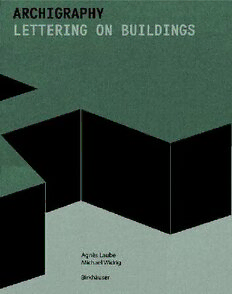
Archigraphy: Lettering on Buildings PDF
Preview Archigraphy: Lettering on Buildings
ARCHIGRAPHY Archigrafie_INHALT_ENG_160602.indd 1 06.06.16 12:16 ARCHIGRAPHY LETTERING ON BUILDINGS Agnès Laube Michael Widrig Birkhäuser Archigrafie_INHALT_ENG_160602.indd 3 06.06.16 12:16 FOREWORD Building signage brings together two disciplines, architecture and graphic design, in a relationship that is summarized by the term archigraphy. In archigraphics, the graphic design constitutes a secondary semiotic layer that should always incorporate its substra te—the architecture. Effective archigraphic designs support the statement made by a building, strengthen its identity, or—deliber ately and for good reasons—form a contrast to it. Designing signage appropriate to a specific building is a com plex task. While most people understand the written code involved, they lack the key to understanding the architecture. How can graphic designers learn to “read,” understand, and interpret architecture and react to it with their designs? Graphic designers usually work in two dimensions and on small scales and are often not aware of the sig nificance of space. How large should lettering be? What is the nature of the sight lines inside and outside buildings? What sorts of materials can be used for lettering, and how can it be constructed and mount ed? Architects, on the other hand, usually have not studied the history of lettering or the typographical applications of fonts. Our methodology is based on the idea of deriving building sig nage and wayfinding elements from the architecture to which they relate. We aim to contribute to and explicitly promote the develop ment of a new signage culture by analyzing current designs as well as looking back at the history of archigraphy. The chapter “Learning from History” traces the development of archigraphy from 1900 on ward and illustrates it with many examples. Wherever possible, con temporary architecture should be marked with equally contemporary signage. This was a premise already adopted by modernist design ers at the beginning of the twentieth century. The new discipline of archigraphy was founded by the architects and typographers of the Neues Bauen (New Building) movement, and some of their (playfully) radical designs still remain groundbreaking today. The examination of recent projects that makes up the core of this publication focuses on the exciting forms of contemporary signage they have produced. Each of these projects illustrates a strategy for de riving integral signage from an architectural design. “Integral” needs to be understood here in a comprehensive sense, that is, not only in terms of the constructive integration of signage into a building but also in terms of its relationship to a particular detail, material, or ground plan. Moreover, signage needs to relate to the utilization and history of the building, the site, and its surroundings. It is precisely when en gaging with a difficult initial situation that integral thinking is required. In such cases the introduction of an unorthodox idea may not only help to solve a signage problem but also enable the designer to find a new form of expression. It is hoped that the strategies shown here will therefore provide inspiration for the discovery of other strategies, for this is a field that still offers enormous scope for experimentation. The chapter “Signage Techniques” offers an overview of the most common signage methods. Historical techniques can be interpreted 4 Archigrafie_INHALT_ENG_160602.indd 4 06.06.16 12:16 in contemporary ways and further developed. In principle, there are few limits to the ideas that can be explored, and digital technologies are offering extensive new scope for experimentation. Finally, when discussing the topic of building signage, consider ation also needs to be given to the influence on the quality of signage exercised by the different stakeholders involved: municipal authorities, building developers, manufacturers, graphic designers, architects, and construction managers. The questions that need to be consid ered here involve not only the concrete design and organization of projects and the provision of adequate budgets for these tasks but also the approach taken by stakeholders to signage commissions, their choice of contractors, and how they organize competitions. The book is rounded off by concrete, practical information on the fun damental planning processes required to design, manufacture, and mount building signage. For a long time, the discussion of signage and lettering was shaped by a discourse focusing on what architecture “in itself” was able to communicate and what signage could contribute to its in terpretation. This skewed relationship is now a thing of the past. It is only when architects and graphic designers enter into an open dia logue that the two disciplines are able mutually to enrich one another. Convincing, multilayered solutions are generated particularly when the theme of signage is integrated into the planning process at an early stage. 5 Archigrafie_INHALT_ENG_160602.indd 5 06.06.16 12:16 Part 1 INTRODUCTION P. 8 Part 2 28 CASE STUDIES P. 42 Part 3 APPENDIX P. 138 7 Archigrafie_INHALT_ENG_160602.indd 7 06.06.16 12:16 Part 1 INTRODUCTION Archigrafie_INHALT_ENG_160602.indd 8 06.06.16 12:16 LEARNING FROM HISTORY A BRIEF HISTORY OF ARCHIGRAPHY P. 10 SELF- AND THIRD-PARTY ADVERTISING THE CASE FOR A DIFFERENTIATED APPROACH P. 30 ORIENTATION THROUGH DESIGN SIGNALETICS P. 36 SEEING OR READING? THE RECEPTION OF ARCHITECTURE AND SCRIPT P. 40 Archigrafie_INHALT_ENG_160602.indd 9 06.06.16 12:16
